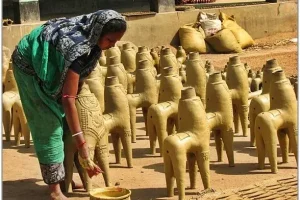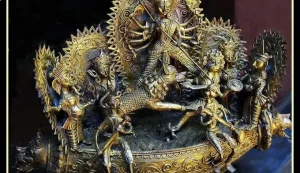Dashavatar (10 incarnations) cards are a part of the rich heritage of Bishnupur in Bankura district of West Bengal. The 10 avatars (incarnations) of Lord Vishnu- Matsya, Kurma, Baraha, Nrisingha, Baaman, Ram, Balaram, Parshuram, Buddha and Kalki are drawn on these cards. The ‘Dashavatar card game’ is a complicated one, played using 120 cards and with numerous rules and regulations.
The Dynasty and the Game Bishnupur witnessed the rise of a glorious tradition of art, craft and culture since the 700 AD under the patronage of the Malla kings of Bankura. The tradition reached its zenith during the reign (1565—1620 A.D) of Malla king Veer Hambir, the 49th ascender to the throne. His long and stable reign can be called the golden era of arts and culture—classical in taste and nature. The tradition was carried forward by his successors King Raghunath Singha and his son Veer Singha. Art, literature and music reached their heights through research, experimentation, training and application. After his conversion to Vaishnavism, according to some authors, under the influence of Vaishnav guru Srinivas Acharya, Veer Hambir was inspired to create a distinct style of art and to nurture a different type of cultural atmosphere in Bishnupur. .
The establishment of Vaishanavism might have had something to do with enjoying pastime in a different and non-violent way and this might have given birth to the game of ‘Dashabatar taas’. Vaishanavism also hints that the game might have been imported from somewhere else, for Dashabatar Taas of Bishnupur was none other form than Dasavtara Ganjifa which used to be played during the time in parts of India like Rajasthan, Orissa, Madhya Pradesh, Andhra Pradesh, Karnataka, Maharashtra and the contemporary Bengal. But Dashabatar Taas of Bankura developed its own distinct form and rules for playing.
Origin and Continuity :
The Ganjifa playing practices in India were introduced and popularized by the Mughal emperors in the 16th century A.D. Dashabatar Taas of Banura Once established, the ganjifa cards spread all over the country in either an original form of Mughal ganjifa or in a slightly hinduized version, painted with Hindu gods and goddesses on it. In India two more suits were added to the mother ganjifa and named all of them after the names of “Dash Abatar” or ten incarnations of Lord Vishnu. The set has thus been known as Dashabatar or Dasavatara ganjifa. This pack generally consists of 120 cards instead of 96 of Mughal set, and in Bishnupur unlike the other states it is played by five players.
The names of the suits of this Dasavatara ganjifa are respectively Matsya (fish), Kurma (turtle), Baraha (boar), Nrisingha (a combination of man and lion together), Baman (Brahmin dwarf), Parasuram (the sixth incarnation with axe), Sri Ram (the hero of Ramayana), Balaram (brother of lord Sri Krishna), Buddha (the ninth incarnation with absolute peace) and Kalki (the ‘abatar’ yet to come).
Every suit of a Dasavatara pack consists of 12 cards each with a Raja as a king or an upper court card and a Mantri as a minister or a lower court card along with ten general numeral cards. The above mentioned suits can be identified with different symbols proficiently painted by the Ganjifa chitrakars (painters in forms of ‘patachitra’ (scroll painting). The suit of Matsya is symbolized with fish, Kurma with an image of turtle, Baraha with shell, Nrisingha with chakra (decorated discs), Baman with water pot, Parasuram with axe, Sri Ram with arrow or bow and arrow or monkey, Balaram with plough or club or cow, Buddha with lotus and Kalki with sword or horse or parasol.
The artists from the Faujdar family of Bishnupur specialise in making these cards. First, a piece of cloth is folded a number of times and pasted using glue made from tamarind seeds. After drying, a layer of chalk dust is applied. Both the sides are evened out with a smooth stone. The cards are then cut into round shapes of 4-and- a-half inch radius. Various deities and their symbols are painted on these using various colours. On the reverse, a layer of lac and vermillion is applied. These beautiful Dashavatar cards are a unique example of Bengal’s folk art.
The Making of Dashabatar Taas of Bishnupur:
It is interesting to note that the Gangifa artists might have been influenced by two traditions here: one, the Dashabatar figures frequently used on the panels of various temples of Bishnupur, and another was the tradition of Patachitra. But still, this cannot explain the mysteries associated with various aspects of Dashabatar Taas. The process of making Ganjifa card is very laborious and it involves almost all the members of a family to bring forth a single set of ganjifa. The Bishnupur Dashabatar Taas are made from old cloth pieces pasting one piece on another by tamarind glue. After pasting layers after layers the stiffened piece of cloth is stretched, dried and cut into circular pieces following coating with a base colour. Then the senior artist touches his brush to draw delicate outlines, details of figure cards and critical touch-ups which require a master’s hand. The junior artists generally draw the numeral cards. Thus the entire family would devote itself to producing a single set of Dashabatar Taas.
The Decline :
Though the game had enjoyed a glorious time (even till the King Kaliprasanno Thakur as per Sital Fouzdar’s report), with the introduction of European printed cards in 19th century fascination with the Dashabatar Taas gradually declined. People rather became more interested in the new European card games as more fashionable. They were also attracted to the stylized figures of French King, Queen and Jack. Just as people started adopting new fashions as part of developing new style during the colonial period, the new game might have had something to do with embracing a new fashion as a symbol of modernity. It is important to note here that many indigenous games were given up in favour of adopting the western ones. Moreover the cost of hand painted Dashabatar Taas was less affordable to the poor and middle class players. The Dashabatar set thus got gradually replaced by the attractive European cards and Ganjifa card artisans became reduced to one or two families creating the cards not for players but for tourists and art-lovers. Many of their families sank into a great poverty, many of the master craftsmen are no more alive today and some of them are suffering from an acute poor vision without any hope.
With the decreasing demand and the lack of interest and awareness among the tourists and general public about the Dashabatar Taas the artisans now are no more interested in taking up Dashabatar Ganjifa as a secure way to earning their livelihood. Only the Fouzdar family of Bishnupur is still engaged in creating the traditional Dashabatar ganjifa and Naqsh taas. But unfortunately they are on the brink of leaving this glorious tradition because of lack of patronage and security for livelihood and minimum respect and recognition for their art. Soon Dashabatar Ganjifa will become extinct and the pieces will find their places in various museums as a cultural fossil unless urgent measures are taken to save this delicate and precious traditional craft.



